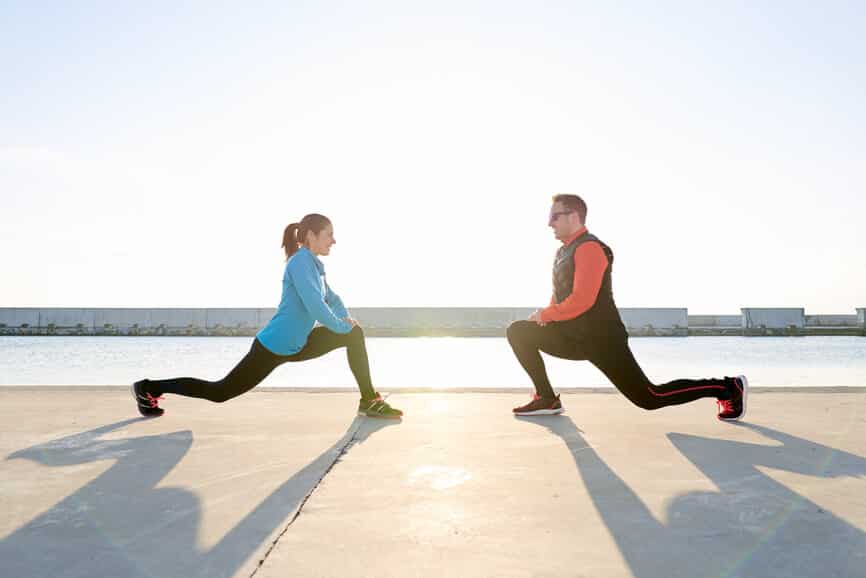5 Exercises You Should Do In Your 40s

If you’re in your 40s, you might have noticed you don’t quite run as fast as you used to, lift quite as much as you once could, or recover as quickly from your latest workouts. Or, even if those don’t apply, you know that over time, you’ll be at greater risk of everything from sore knees and backaches to heart problems and other assorted injuries — even if you’re in the best shape of your life.
Whatever the case, there are steps you can take now to help improve the quality (if not necessarily increase the quantity) of your remaining years. We talked with a 40-something trainer from the fitness app Aaptiv — a subscription is available at no cost for eligible Haven Term policyholders via our Haven Life Plus bonus rider — to get some tips. Here’s trainer Wes Pedersen on how to boost long-term health, and become more injury proof as you age.
Keep on moving
Finding the best way to exercise in your 40s “is something I’m literally living through as we speak,” says Pedersen. “I’m 42.” As we get older, “we don’t move as much,” he says, which means the body becomes stiffer and more prone to mishaps. “Long term it’s important for the body to remain flexible to prevent injury,” he adds.
To boost flexibility, Pedersen recommends starting the day with “a 6-10 minute mobility routine. I use the weird ‘mobility’ intentionally,” he says. “I don’t think of it as a stretching routine, because most people think of stretching as something more static. This is more akin to the yoga flow. It’s a lot of things that add mobility, so rather than a toe touch, I’d rather be doing leg sweeps or swings. Rather than sitting and doing the splits I’d rather be doing lateral lunges in a pattern.” He includes “everything from child’s pose to downward dog to world’s greatest stretch and pigeon pose,” all in motion. If you already have stretches you like to do, the key here is to convert them into movement.
“When you’re moving as opposed to doing static stretches, you’re working a little bit harder,” says Pedersen. “With more movement comes more activity and therefore more blood flow and the muscles work more. If you’re moving through a range of motion that is weight bearing, the tendons, cartilage and bones are all stimulated,” which helps keep them strong and resilient over time.
Build strength without strain
In your 40s you still can (and should) do strength training, but you have to make some changes to your approach. “In my 20s, I could work out hard multiple days a week and my body would bounce back pretty darn quickly,” says Pedersen. “Now it takes longer, so you have to be mindful of how many days a week you do really hard workouts and the other days need to be slower tempo—very consistent, speed strength training days.”
Pedersen says someone in their 40s can still do some kind of strength training up to four or five times a week, but most of those sessions should be “less high intensity and more like an old-school bodybuilder format: lunges, squats, deadlifts, pull-ups.” Using body weight resistance puts less strain on the body while keeping it strong, and the added mobilization control is also beneficial for long term strength and flexibility.
Pedersen recommends that your workout time be around 60% body resistance, 20% “very concentrated strength stuff; deadlifts bench presses, time with barbells,” and the remaining 20% being exercise that gets your heart rate elevated. (Don’t forget, the heart is a muscle too.) This, can be just cardio, something that combines strength and cardio, he adds.
Do these five key moves
Pedersen recommends the following exercises, which you can find on Aaptiv as part of a workout, or do on your own.
Lunge with balance
“Any type of lunge where you’re using balance as a component is great, such as a Curtsy lunge.” This works the lower leg muscles like a normal lunge, but also improves stability and body alignment, which can help reduce the likelihood of lower back pain.
Rowing
“Some type of rowing is very valuable, because as we age it’s really useful to still have good posture and also drive the elbows and shoulders back.” Rowing also gets the heart going.
Deadlifts
These are a time-efficient way to build and maintain muscle. Just be sure to add weight gradually and to mind your form, otherwise you risk hurting your back.
Push ups
“A body weight push up is great just for general upper body strength.”
World’s greatest stretch
This is good for balance, hips, lower legs and thoracic spine mobility. Crucially for busy people who want long term health but not long-winded workouts, it also doesn’t take very long.




